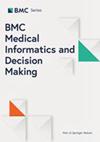Development and validation of a nomogram for predicting critical respiratory events during early anesthesia recovery in elderly patients
IF 3.3
3区 医学
Q2 MEDICAL INFORMATICS
引用次数: 0
Abstract
Elderly patients undergoing recovery from general anesthesia face a heightened risk of critical respiratory events (CREs). Despite this, there is a notable absence of effective predictive tools tailored to this specific demographic. This study aims to develop and validate a predictive model (nomogram) to address this gap. CREs pose significant risks to elderly patients during the recovery phase from general anesthesia, making it an important issue in perioperative care. With the increasing aging population and the complexity of surgical procedures, it is crucial to develop effective predictive tools to improve patient outcomes and ensure patient safety during post-anesthesia care unit (PACU) recovery. A total of 324 elderly patients who underwent elective general anesthesia in a grade A tertiary hospital from January 2023 to June 2023 were enrolled. Risk factors were identified using least absolute shrinkage and selection operator (LASSO) regression. A multivariate logistic regression model was constructed and represented as a nomogram. Internal validation of the model was performed using Bootstrapping. This study followed the TRIPOD checklist for reporting. The indicators included in the nomogram were frailty, snoring, patient-controlled intravenous analgesia (PCIA), emergency delirium and cough intensity at extubation. The diagnostic performance of the nomogram model was satisfactory, with AUC values of 0.990 and 0.981 for the training set and internal validation set, respectively. The optimal cutoff value was determined to be 0.22, based on a Youden index of 0.911. The F1-score was 0.927, and the MCC was 0.896. The calibration curve, Brier score (0.046), and HL test demonstrated acceptable consistency between the predicted and actual results. DCA revealed high net benefits of the nomogram prediction across all threshold probabilities. This study developed and validated a nomogram to identify elderly patients in the PACU who are at higher risk of CREs. The identified predictive factors included frailty condition, snoring syndrome, PCIA, emergency delirium, and cough intensity at extubation. By identifying patients at higher risk of CREs early on, medical professionals can implement targeted strategies to mitigate the occurrence of complications and provide better postoperative care for elderly patients recovering from general anesthesia.开发并验证用于预测老年患者早期麻醉恢复期间呼吸系统危急事件的提名图
从全身麻醉中恢复的老年患者面临着更高的危重呼吸事件(CRE)风险。尽管如此,针对这一特殊人群的有效预测工具却明显缺乏。本研究旨在开发并验证一种预测模型(提名图),以填补这一空白。在全身麻醉恢复阶段,CRE 对老年患者构成重大风险,因此成为围手术期护理的一个重要问题。随着人口老龄化的加剧和外科手术的复杂化,开发有效的预测工具以改善患者预后并确保麻醉后护理病房(PACU)恢复期间的患者安全至关重要。2023 年 1 月至 2023 年 6 月期间,在一家甲级三等医院接受择期全身麻醉的老年患者共有 324 人。采用最小绝对收缩和选择算子(LASSO)回归法确定了风险因素。构建了一个多变量逻辑回归模型,并以提名图的形式表示。模型的内部验证采用 Bootstrapping 方法进行。本研究遵循 TRIPOD 清单进行报告。提名图中包括的指标有体弱、打鼾、患者自控静脉镇痛(PCIA)、急诊谵妄和拔管时的咳嗽强度。提名图模型的诊断效果令人满意,训练集和内部验证集的 AUC 值分别为 0.990 和 0.981。根据尤登指数 0.911,确定最佳临界值为 0.22。F1 分数为 0.927,MCC 为 0.896。校准曲线、布赖尔得分(0.046)和 HL 检验表明,预测结果与实际结果之间的一致性是可以接受的。DCA 显示,在所有阈值概率中,提名图预测的净效益都很高。本研究开发并验证了一种提名图,用于识别 PACU 中发生 CRE 风险较高的老年患者。确定的预测因素包括虚弱状况、打鼾综合征、PCIA、急诊谵妄和拔管时的咳嗽强度。通过早期识别CREs风险较高的患者,医务人员可以实施有针对性的策略来减少并发症的发生,并为全身麻醉后恢复的老年患者提供更好的术后护理。
本文章由计算机程序翻译,如有差异,请以英文原文为准。
求助全文
约1分钟内获得全文
求助全文
来源期刊
CiteScore
7.20
自引率
5.70%
发文量
297
审稿时长
1 months
期刊介绍:
BMC Medical Informatics and Decision Making is an open access journal publishing original peer-reviewed research articles in relation to the design, development, implementation, use, and evaluation of health information technologies and decision-making for human health.

 求助内容:
求助内容: 应助结果提醒方式:
应助结果提醒方式:


